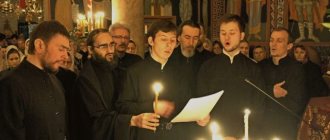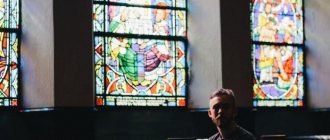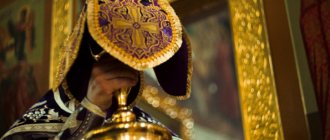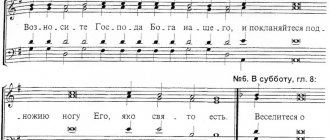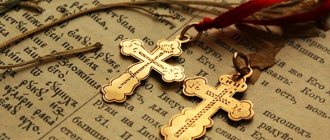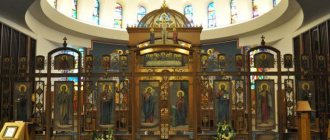Contents and symbolism of visual antiphons
“Iconic” psalms 102 and 145 represent an enthusiastic and joyful glorification and thanksgiving to God for His mercy, which is expressed especially in relation to sins and help to the unfortunate, coming from the depths of the soul. During the singing of the antiphons, the priest is in the altar and reads the so-called secret priestly prayers.
Previously, secret prayers were read aloud - there is no secret in them; it's all about their incomprehensibility and greatness. However, starting from the 6th century, they are read quietly in the altar, which reveals a certain external division between those who officiate at the Throne and those who officiate as the people of God. According to many theologians, the power of sacred rites is thus weakened. Unfortunately, now we are reaping the fruits of this reduction, because in the minds of many people only the priest performs the Liturgy, only he prays, and everyone else is just present. In fact, this is not so - all prayers during the Divine Liturgy are offered on behalf of all those gathered in the temple. Each of us should know and understand them. Antiphons and litanies do not replace priestly prayers, but are their continuation.
After the first and second antiphons “depicted” the Kingdom of God from the Old Testament point of view, the third antiphon gives a New Testament picture of this Kingdom, beginning with the prayer of the prudent thief to accept us into it: “ In Your kingdom, remember us, Lord
" First of all, the sounding beatitudes paint us an image of the Lord Jesus Christ Himself, in His earthly life before His appearance to the people, spent in the obscurity of Nazareth. These blessed ones depict the steps of human ascent to God along the ladder of virtues based on the words of Christ Himself in His Sermon on the Mount (Matthew 5:1–12; Luke 6:20–26). Before the mental gaze of those listening to the singing, states of exaltation to God pass one after another, such as: poverty of spirit, crying for sins, meekness, greed and thirst for justification, mercy, purity of heart, peacemaking among neighbors, patience with persecution and reproach for confessing the name of Christ.
At the end of the singing of the blessed, the entrance with the Gospel is made, the so-called small entrance, which, according to the general opinion of interpreters, marks Baptism and the beginning of the preaching of the Savior, as well as the “entry of the saints” into the Kingdom of Heaven. Believers are invited to fall and worship Christ and cry out to Him for personal salvation. At the small entrance they carry a candle, followed by the Gospel, and then the priest walks on. The candle represents the Forerunner of the Lord – John, the Gospel – Jesus Christ Himself.
The classical Byzantine liturgical commentaries give the following symbolic interpretations of the small entrance. St. Maximus the Confessor sees in it an indication of the Incarnation of God and, more broadly, the entire dispensation of the salvation accomplished by Christ, as well as the conversion of people from sin to righteousness. In the "Ecclesiastical History" of St. Herman I of Constantinople (8th century) explains the small entrance as a sign of the coming into the world of the Son of God in the Incarnation. Nicholas and Theodore of Andida see in the small entrance a symbol of the Baptism of the Lord; St. Nicholas Kavasila - an indication of the appearance of Christ; blzh. Simeon of Thessalonica understands the small entrance as a sign of the participation of angels in the ministry of Christ and in the celebration of the Liturgy, and also sees in this a symbol of the Resurrection of the Lord.
Feast of All Saints. Small entrance to the blessed ones. Skete of All Saints.
"Blessed are you"
By “Blessed” (Greek: μακαρισμοί) we mean: firstly
, gospel verses about bliss (Matthew 5:3-12), promised from the Lord for various virtues;
secondly
, special chants (troparia), which are sung at the Liturgy behind the verses about beatitude. It is in this last meaning that the word “Blessed” is most often used in the Typikon and other liturgical books. Troparia, read or sung with verses about beatitude, serve as confirmation, example, evidence of how virtues lead people to beatitude and clarify the power of Christ’s merits.
Types of troparions on the blessed
The existing cycles of troparia for the blessed can be divided into three categories: Sunday
,
everyday
and
holiday
.
The most ancient are the cycles of Sunday
troparions on the blessed (known already from Greek manuscripts of the 9th century);
together with the later cycles of everyday
troparions (their origin is associated with the activities of the Constantinople hymn-makers St. Joseph the Songwriter, St. Theophanes the Inscribed), they belong to the hymns of the weekly circle of worship and are placed in the Octoechos at the end of the sequence for each day. In the Octoechos, now used in the Orthodox Church, there are 8 troparions on the blessed for the services of weeks (Sundays), and for the remaining days of the week - 6.
Holidays
The blessed troparions are dedicated to various commemorations of the church year (moving and stationary liturgical circles). This category of troparions on the blessed was less common than the first two; special holiday troparia for the blessed ones are found only in some manuscripts (Minaia and Triodion). Since the 14th century, after the widespread transition to the Jerusalem Rule (which knows only the troparions on the blessed Octoechos, and for the holidays of the annual circles uses separate songs of the morning canons), the genre of festive troparions on the blessed ones disappears from liturgical books. In the Colored Triodion currently used in the Orthodox Church, such hymns are found at the end of the successive week (i.e., Sunday), with 4 troparions per blessed, but in the Menaion and Lenten Triodion there are no such hymns. However, some successions still have special troparions for the blessed ones - for example, the services of “All Saints Who Have Shined in the Land of Russia”, “Mr. Julian of Egypt" (in the Menea of the Moscow Patriarchate published on June 2, 21).
From the Menaion and Triodeum, the blessed holiday troparions are sung with the song of the canon laid down at Matins, namely 3 and 6 songs or others, which the Typikon often assigns for singing either instead of Blessed Octoechos, or together with them. Such songs in the canon must have been chosen in accordance with the numbering of the 3rd and 6th hours with which the Liturgy is celebrated. These times of the day are especially sacred for the sacraments of viewing that took place in them: the third - by the descent of the Holy Spirit on the apostles; sixth – by the devouring (crucifixion) of the Savior himself on the cross. If we delve into the content of the songs of the canon, we will see that the 3rd and 6th songs (or their individual troparia) depict those who mourn and then receive consolation and joy, just as is promised in the verses of the biblical songs. The third song of the canon is modeled on the song of Anna: “ My heart be established in the Lord.”
"
The sixth hymn is modeled after the song of St. Prophet Jonah: “ I cried out to the Lord in my sorrow
.”
Hymns to Mary
Marian antiphons are Christian songs dedicated to the Virgin Mary. They are used in the services of the Roman Catholic, Eastern Orthodox, Anglican and Lutheran churches. Most often they can be heard in the monthly prayers of May. Some of them were also adopted as Christmas antiphons. Although there are a number of ancient Marian hymns, the term is most often used to refer to four hymns:
- Alma Redemptoris Mater (Advent until February 2).
- Ave Regina Kelorum (Introduction of the Lord through Good Friday).
- Regina Koepi (Easter season).
- Salve Regina (from the first Sunday evening of Trinity to Advent).
The structure of the cycles of troparions on the blessed
Troparia on the blessed belong to complex genres of church hymnography and consist of many small chants. The groups of troparions on the beatitudes have a structure similar to that of the canon.
The 1st troparion is usually not connected in meaning with the remembrance of a day or holiday and plays the same role as the irmos in the canon. In manuscripts it is regularly designated as irmos (as opposed to modern printed liturgical books). The same irmos can be used in different groups of troparions on the blessed. The 1st Troparion of the Sunday Troparions Octoechos on the Blessed is used as the Irmos of the Troparions on the Blesseds on weekdays of the week of the corresponding tone. The 1st troparion on the blessed matins of Good Friday is the Sunday Irmos of the troparions on the blessed 4th tone. There are, however, exceptions to this rule: the irmos of the troparions on the blessed on Thursday of the Great Canon, in the sequences of lay, monastic and priestly burials, etc. are unique.
After the Irmos, troparions follow, dedicated to the remembrance of a day or holiday: resurrection, martyrdom, death, troparions in honor of angels, saints, etc. These troparions reveal the meaning of the holiday or remembrance of a given liturgical day. At the end of the cycle, the Trinity and the Theotokos are usually given. The ternary is sometimes absent. Trinity - just like the irmos on the blessed ones - are often the same for several cycles. In ancient Slavic manuscripts, the Octoechos trinity of Sunday troparions was repeated on weekdays. In the later Octoechos, different trinities appeared for each day; in the modern printed Octoechos there are some traces of the ancient use of the Sunday trinity throughout the week: the Sunday trinity of the 1st tone is also sung on Monday and Saturday, the Sunday trinity of the 4th tone - on Tuesday, the Sunday trinity of the 6th tone - on Saturday.
Development
In the eighth century the antiphons consisted of:
- 92 Psalm with the refrain “Through the prayers of the Mother of God, Save, Save us!”;
- 93 Psalm with the refrain “Save us, Son of God... Hallelujah!”;
- Psalm 95 with the hymn "The Only Begotten Son" written by Emperor Justinian in the 6th century.
In the 12th century, some monks in Constantinople began the innovative custom of replacing Psalms 103, 146 and the Beatitudes with normal antiphons in the Sunday liturgy.
Today some churches follow this custom. But mostly the singing of Psalms 92, 93 and 95 is used as the main antiphons. Whatever hymns are used, these three songs begin all services.
Singing troparions for the blessed at the Liturgy
According to the Jerusalem Rule, currently accepted in the Orthodox Church, the figurative antiphons at the Liturgy, when they are appointed, are sung with the troparions of the blessed ones.
The 1st troparion of Octoechos, which has lost the name “irmos” in modern books, or the irmos of Menaion or Triodiion is always sung first on the beatitudes. If several (2 or 3) cycles of troparions are sung together at the beatitudes, then all but the 1st should be sung without irmos, similar to the order of singing the songs of the canon of daily matins.
Per week (Sunday)
, if the memory of a saint without a holiday sign falls on it (which usually does not have blessed ones), the troparions of Octoechos are sung on the blessed ones on 8. If the day has a sex sign and higher, 10 troparions are sung on the blessed ones - to the troparia of Octoechos (which are then sung on 6) the 3rd (sometimes 6th) hymn of the morning canon of the holiday or memory of the saint is added (at 4). If the memory of the celebrated saint in a week falls on the after-feast of the twelfth feast, then the troparia for the blessed are sung on 12: 4 Octoechos, 4 feasts and 4 saints; This order is always observed when 3 cycles of troparions must be sung at the blessed ones.
On weekdays
at the sign of the sixfold service on the blessed, 4 troparions of Octoechos and 4 Menaions from the 3rd song of the canon (sometimes the 6th) are sung on 4. Several saints with the sixfold sign (September 6, January 16, July 20) also have a 3rd , and the 6th song on the blessed (the blessed Octoechos are then canceled completely). On days with doxology and above, it is necessary to sing songs 3 and 6 on the blessed ones. If a saint or holiday has 2 canons at Matins, then the 3rd canto is taken from the 1st, and the 6th from the 2nd canon.
On Saturday
, if the service to the saint does not have a holiday sign, 6 troparions of Octoechos are sung at the blessed; if there are troparions for the blessed ones, the rules for singing them are the same as on weekdays, only the troparions of the saint are sung before the troparions of Octoechos (if the latter are not canceled at all). On the days of remembrance of saints who have a sixfold service, when first the hymn of the canon of the Menaion with the Irmos is sung on the blessed, and then the troparion of the Octoechos, and the 1st troparion of the Octoechos (i.e., the Irmos of the troparia on the blessed) is omitted, by analogy with the canon. This rule is directly stated in the Moscow old printed Typikon of 1641 under September 7.
On the after-celebrations of the twelve feasts, most weeks of the period of Pentecost and the feast of Midnight, the troparia of Octoechos are canceled and the so-called troparions are sung instead. ordinary songs on the blessed - songs of the festive canon (or 2 canons) in turn, starting with the 1st. The distribution of songs of the festive canon among the days after the feast is subject to certain patterns. If the post-feast with giving covers 8 days, which is enough to sing all the songs of the holiday canon, then the songs of the canons are sung all in a row - from the 1st to the 9th, one per day. Epiphany, Ascension and Dormition have an 8-day post-feast. The after-feast of other holidays is shorter: Exaltation - 7 days, Nativity of Christ, Pentecost, Transfiguration - 6 days, Nativity of the Virgin Mary, Entry into the Temple - 4 days. The Presentation of the Lord can have a different number of days of celebration (from 0 to 7 - this is due to the fact that the holiday depends on the moving annual circle). If there are not enough days, first of all the songs already sung on the day of the holiday or on the 1st day of the after-feast (for the after-feasts of the Nativity of the Virgin and the Entry) are skipped. To sing all the songs of the holiday canon, if there are not enough days, the songs are combined with each other (for example, the 4th with the 5th, the 5th with the 6th, the 7th with the 8th). The Typikon avoids connecting songs separated by litanies at Matins (i.e., songs 3 with 4 and 6 with 7 are never connected), as well as any songs with 1 and 9. Most often, the 7th and 8th songs are combined (apparently because the corresponding biblical songs are closely related to each other). If the days are still not enough to sing all the songs of the holiday canon, then the 3rd and 6th songs are sung first, if they have not yet been sung, and if they have been sung, then the 9th. On the day of the celebration, the 9th hymn is usually sung. Ordinary songs of the post-celebration of the blessed ones are sung at 6, with Irmos. If a holiday has 2 canons, both should be sung on the blessed ones, but still on 6. When the troparions of the celebrated saint are added to the troparions of an ordinary song on the blessed ones, then a total of 8 troparions are sung on the blessed ones: 4 holidays (only one of the canons) and 4 saints . In the week during which the saint is celebrated, 12 troparions are sung during the post-feast of the blessed ones.
On Sundays of the period of Pentecost (except for the 1st, 5th, 7th and 8th), the troparia for the blessed are sung not on 10, but on 8 (Sunday on 4 and the Triodion (from the canon) on 4). Here, modern Russian practice comes close to modern Greek, according to which, throughout the year, both on Sundays and on weekdays, when there are blessed ones, songs from the canon of the troparia of Octoechos are sung at 4 and the song of the canon of Menaion or Triodion at 4. In the first printed Moscow Typikon, on the contrary, The troparia of Octoechos are indicated to be sung at 6 (and on weekdays), and the hymn of the canon – at 4.
The blessed ones are sung in a special melody of alternating voices, close to the troparion and canon.
Catholicism
In Catholicism, antiphons are used at Mass, during Vespers, and during all canonical hours. They have their prescribed place in almost every liturgical function. The essence of antiphonal psalmodies is the alternation between soloists and choir. during execution.
In the fourth century, alternative singing, which until then had been used only in secular gatherings, found its place in the worship gatherings. This does not mean that antiphonal singing was new. It was successfully used in the Synagogue. The real novelty was the inclusion of a more ornate melody. The soloist chanted the text of the psalm, and at certain intervals people took up the singing with a refrain.

